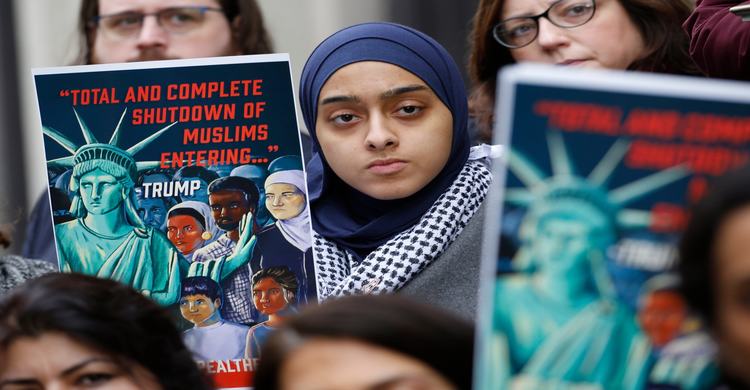The racism at the heart of Trump’s ‘travel ban’

By Jamelle Bouie
It’s happening a little bit out of public consciousness — swamped by impeachment, the coronavirus and the Democratic presidential race — but on Friday President Trump announced further restrictions on immigration and foreign entry to the United States. Citing security concerns, the administration has slammed the door on immigrants from the African nations of Sudan, Tanzania and Eritrea, as well as Myanmar in Southeast Asia and Kyrgyzstan in Central Asia. These countries, which have large Muslim populations, join seven others on the president’s ever-developing travel ban.
There’s one other country on the expanded list — Nigeria. Home to more than 200 million of Africa’s 1.2 billion people, Nigeria has the largest economy on the continent and has worked with the American military on joint operations. But given an “elevated risk and threat environment in the country,” administration officials say there’s a chance Nigeria could become a vector for terrorists who want to enter the United States. Nigeria’s government has long struggled with the Islamist group Boko Haram, which is responsible for multiple kidnappings and dozens of attacks that amount to mass slaughter.
But there’s little to no evidence that this group is a threat to Americans, nor is there any history of Nigerian terrorism on American soil. From 1975 to 2015, according to an analysis from the libertarian Cato Institute, just one Nigerian national was implicated in a terrorist attack against the United States. And, it should be said, the administration has not banned all entry from Nigeria — only applications for permanent residence. Tourists can still visit America, an odd loophole if the White House is actually worried about terrorism.
But I don’t think President Trump is actually worried about Nigerian terrorism.
In 2017, The New York Times reported on a meeting between Trump and several members of his cabinet in which he raged against foreign visitors to the United States. Citing a memo from Stephen Miller, the president’s chief immigration hard-liner, Trump complained about the pending arrival of thousands of people from Muslim and predominantly African nations. They “all have AIDS,” Trump reportedly said, about immigrants from Haiti. As for Nigerians? Once they saw America, they would never “go back to their huts.”
All of this was separate from the president’s remarks on what he famously called “shithole countries” — those came the next year, when he found a fresh way to articulate his racist vision of immigration policy, where white Europeans are welcome and nonwhites are not.
Which is to say that it does not matter that Nigeria isn’t much of a national security threat or that Nigerians are among the most successful immigrants to the United States, surpassing native-born Americans in income and educational attainment. What matters is that they’re black and African and, for Trump, at the bottom of a racial hierarchy.
I’ve written before about the 1924 Immigration Act, also known as the Johnson-Reed Act, which codified a decade’s worth of nativist hysteria into law. It followed the Immigration Act of 1917, which imposed literacy tests on new immigrations and barred immigration from the Asia-Pacific region, and the Emergency Quota Act of 1921, which established the first per-country percentage limits on the number of immigrants to the United States. The 1924 act was the harshest. It was also the most far-reaching. Meant to reduce immigration from Southern and Eastern Europe, it also defined the American nation in explicitly racial terms.
The quota system established by Johnson-Reed, the historian Mae Ngai writes, “subtracted from the total United States population all blacks and mulattoes, eliding the difference between the ‘descendants of slave immigrants’ and the descendants of free Negroes and voluntary immigrants from Africa. It also discounted all Chinese, Japanese and South Asians as persons ‘ineligible to citizenship,’ including descendants of such people with American citizenship by native birth.”
In doing so, Ngai continues, the 1924 Immigration Act “excised all nonwhite, non-European peoples” from its “legal representation of the American nation,” setting the stage for the “racialization of immigrant groups around notions of whiteness, permanent foreignness and illegality.”
Trump is almost certainly ignorant of the Johnson-Reed Act (Stephen Miller, on the other hand, is not). But he’s channeling the impulse of that law — the attempt to cast the United States as a white nation, off-limits to those who don’t fit his preferred racial type. And with the Supreme Court’s blessing (granted to the revised version of the original travel ban), he’s doing just that: using his immigration policy to resurrect and reconstitute the exclusions of the early 20th century.
Although immigration policy deals with the external boundaries of the United States, the elevation of whiteness has internal consequences as well. Not because the president intends to distribute benefits and favors on the basis of race — although there are elements of that in his administration’s behavior — but because it sends a larger signal about who matters in this society. Every time Trump and other members of his administration make the decision to stratify and racialize, they are also making a statement about who receives a voice and who deserves respect.
Source: New York Times



